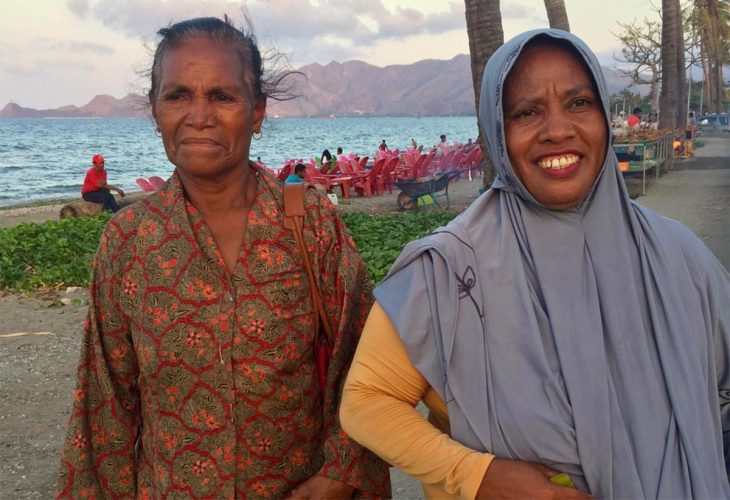“I am very grateful that my parents are still alive. I am so thankful for this beautiful moment,’ smiles Zequelina Soares, 48, whose given name is Arsica, while sitting next to her mother. She arrived a few days earlier, on 11 November 2019, from Indonesia for an emotional reunion with her family in East Timor after having been separated for 41 years. “I cried when I saw her. I embraced her,” says her mother Anita Soares, now 65, her eyes lighting up for a moment. “Not one single day has passed that I didn’t think about my daughter. I remember her so well. She was such a cute, lively, happy and healthy girl,” Anita recalls while her husband, Marcelino Soares, 68, sits quietly in a chair and nods.
In 1975 Indonesia invaded East Timor with extreme violence. The population was bombed, terrorised, killed, tortured, raped, uprooted and starved. Marcelino joined the East Timorese Fretilin guerrilla fighters, while Anita fled like hundreds of thousands Timorese to the mountains hoping to be safe, but suffering violence, hunger and disease, as the Indonesian army wreaked havoc.
In 1978, out of despair, Anita and her family surrendered. The Indonesian military forced them down the mountain. “We arrived at a river,” recalls Anita, while taking her daughter’s hand. “An Indonesian commander grabbed Arsica. He said: ‘She is mine, not yours.’ I cried and fought back so he could not take my child.” The little girl started crying out of fear. Then the commander hit Anita with a gun and forced her to the ground. She hit him back. Twice. “I was so angry. The commander wanted to shoot me. When I was about to be shot, another soldier calmed the situation down to draw the attention away. Then the commander took my child.” It was the last time Anita Soares saw her daughter.
The Truth Commission’s findings and forgotten recommendation
During an historic referendum in 1999, the Timorese voted for independence. In 2005, the Commission for Reception, Truth and Reconciliation (CAVR), tasked to investigate human rights violations between 1974 and 1999, published its final report Chega! (a Portuguese word that translates as: no more, stop, enough). The CAVR stated that during the Indonesian occupation, at least four thousand children were forcibly removed from their families and taken illegally to Indonesia. Military abducted children from their families to break the resistance, to use them as child soldiers or servants at home. Islamic organisations converted children to Islam. Even if institutions and individuals had more charitable motives or if permission was requested from families, not much effort was made to maintain contact, which resulted in most children losing their roots. The “separation of a child from its true identity, culture, ethnicity, religion or language” is a grave breach of the fourth Geneva Convention and constitutes a war crime, the Chega! report concluded.
The stolen children are part of a wider crime of forced disappearances in East Timor. The Chega! report stated that 18,600 East Timorese citizens were killed or disappeared during the conflict. Both the CAVR and the Commission on Truth and Friendship (CTF) – another truth commission jointly set up by Indonesia and East Timor in 2005 – compelled the two governments to create a special commission to search for the missing. This, however, did not happen. “There is no political will, particularly from the Indonesian side, to materialize the recommendation to set up this commission,” says Sisto dos Santos, the outreach director of HAK Association, a human rights organisation in East Timor.
Indonesia signed but didn’t ratify the International Convention for the Protection of All Persons from Enforced Disappearance. East Timor didn’t even sign it. “Our government says it is easier for East Timor to follow if Indonesia first ratifies,” says Dos Santos. “Politically we are independent, we have a national flag and a president. But with regard to the issue of past crimes by Indonesia, our politicians are still influenced by the Indonesian government. The struggle to find the truth still goes on.”
A continuing crime
While governments remained inactive, in 2010 East Timorese and Indonesian activists took the initiative to work together to find the stolen children, often using their own money and resources. In 2013 a working group was established by Timorese and Indonesian NGOs and organisations. The efforts of the group are supported by East Timor, but not by the Indonesian government. “So far we have traced 138 children. We have reunited about eighty of them with their families,” explains Dos Santos.
Their work can be challenging. “When Indonesian colleagues were trying to trace some children, several Indonesian military tried to stop them as they were directly involved in the disappearances,” says Dos Santos.
The fate of most of the stolen children is not known. “Enforced disappearance is a continuing crime as long as the families don’t know what happened to the children,” stresses Dos Santos. As time passed, several Timorese families assumed their lost children had died and made symbolic graves. “If stolen children are found alive and reunited with their families, the children have to do a ceremony to be taken out of the grave, which again is very traumatising,” Dos Santos says. “East Timor brought my daughter back,” pleads Marcelino Soares, Arsica’s father, “but I want the governments to help other families with information as well, in order to bring all the lost children back home.”
Living apart
Immediately after 7-year old Arsica was violently abducted, Anita Soares searched for her daughter. But while the stolen girl initially stayed not far in a military camp in the town of Aileu, it was impossible for Anita to find her. After some time Arsica’s abductor, commander Nampoleaun, took her to the Indonesian province of Sulawesi, where the stolen girl lived for one year alone with him, while he was still unmarried, in military barracks. When Nampoleaun got married and had children, Arsica became part of the family. “I don’t know why my stepfather took me from East Timor,” Arsica says. “But he took good care of me. I was not abused. I had a normal life,” she says. When she is asked to spell the name of her stepfather, however, she admits she is illiterate. A painful silence follows, which she immediately breaks. “I didn’t want to go to class and I always ran away from school,” Arsica smiles. “But that’s something I now regret.”
Arsica got a new name: Yanti. The Catholic girl became Muslim. “But my stepfather never hid from me that I was Timorese,” she says. “The only thing that makes me feel bad is that I did not grow up with my own parents. I feel the emptiness. It makes me very sad now.”
While Arsica grew up in Sulawesi, her Timorese family was living in fear. The CAVR established that the Indonesian occupation claimed at least 102,800 lives mostly because of hunger and illness, though the death toll could be as high as 183,000, on a population of about 600,000 people. Two daughters of Anita and Marcelino died of hunger. Despite the hardship, the couple still managed to get their six other children to school.
In all those years only twice they received notice that their abducted daughter was still alive. In 1989, unexpectedly, there was a message from the commander who was back in East Timor, in the town of Ainaro. “When I met him, he told me: ‘Your child is with me, and she is fine’”, says Marcelino. “But I was sad because she was so far away. He gave me their address and telephone number in Sulawesi. But I never heard anything from her.”
Then in 1991 Marcelino sent a letter to his daughter through the Indonesian Red Cross. “I replied,” says Arsica, who was helped to write her letter. Marcelino wrote back, but his letter ended up with a corrupt person. “To be able to receive the letter, the [Indonesian] Red Cross asked 8 million rupiah [now some 500 dollars],” Arsica says. She refused to pay. The contact with her family ended.
Lack of will, lack of funds
Arsica was only found last July by the NGOs. In November she travelled to East Timor as part of a group with thirteen other stolen children. Seven such grouped reunion trips have been organised thus far. “But Indonesia still doesn’t show any goodwill,’ says Dos Santos. The central government in Jakarta only gave 3,000 dollars for the last trip, while East Timor paid 37,000 dollars. NGOs, the International Red Cross and the Red Cross in East Timor paid the rest.
During the welcome ceremony in November, the current Indonesian ambassador to East Timor said he objected to the word “stolen” children and preferred the term “separation”. Dos Santos says that semantics are “part of the distortion. They create a new narrative which is a perversion of the truth itself. We see this happening for all the crimes committed by Indonesia, including the stolen children. They don’t want to recognize their past and make sure they never have to apologize.”
Dos Santos calls on the international community to support the quest for justice. ‘There is impunity and there haven’t been reparations for the survivors,’ he says. Recently the Centro Nacional Chega (CNC), an independent institution in East Timor tasked to facilitate the implementation of the recommendations of the CAVR and CTF, established a support program for the most vulnerable victims of the occupation to which donors, individuals and other states can financially contribute. “The parents of the stolen children, many of whom live in poverty, are one of the beneficiary groups,” says the outreach director of HAK.
The reunion, at long last
Immediately after Arsica’s arrival in East Timor, her family took her to their home in Aileu. To welcome her and bring back her soul, her uncle sprinkled water on her. The family wrapped her in tais, a coloured traditional woven cloth. It never even crossed their minds to make a grave for her, says her mother. They always kept the hope alive that one day she would return.
Communicating, however, was difficult. Arsica has forgotten her mother tongues, Tetum and Mambai. She speaks Indonesian, a language her mother understands but cannot speak. They mostly smiled and held hands. The fact that she wears a hijab was not a problem. “There is only one God,” says Marcelino.
While Arsica was in East Timor the commander phoned Marcelino. “I thanked him for looking after my daughter for many years. The commander thanked me too,” Marcelino says.
But when Anita was asked about the commander, her eyes couldn’t hold the anger. “He hit me and almost shot me. He took my child by force. He promised to look after my child, but she never went to school. I don’t forgive him.”
The pain of the upcoming farewell was palpable. For a week Arsica felt the warm embrace of her Timorese family. But her life is in Indonesia, where she has two children and grand-children. Every day her Indonesian family has been calling her. “They ask me not to stay in East Timor, but to get back as soon as possible,” she says.
Arsica says she will come back to see her Timorese family, although she has no money for the journey. Her mother Anita fears the worst. With tears in her eyes she says: “I am afraid I might never see her again.”
This article was published in a slightly different version in Tempo Timor (in english) and in Dutch language in Amnesty International Netherlands magazine.





